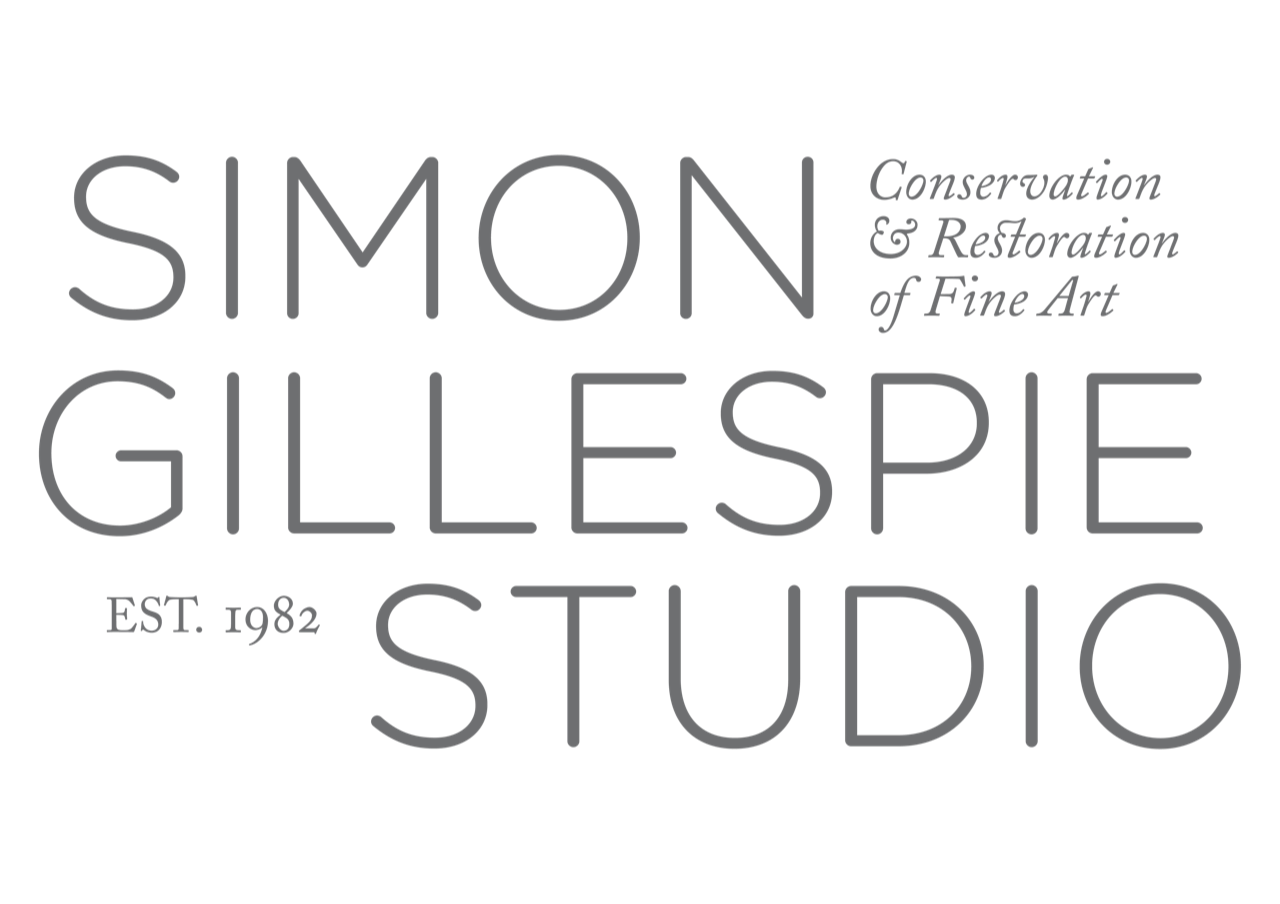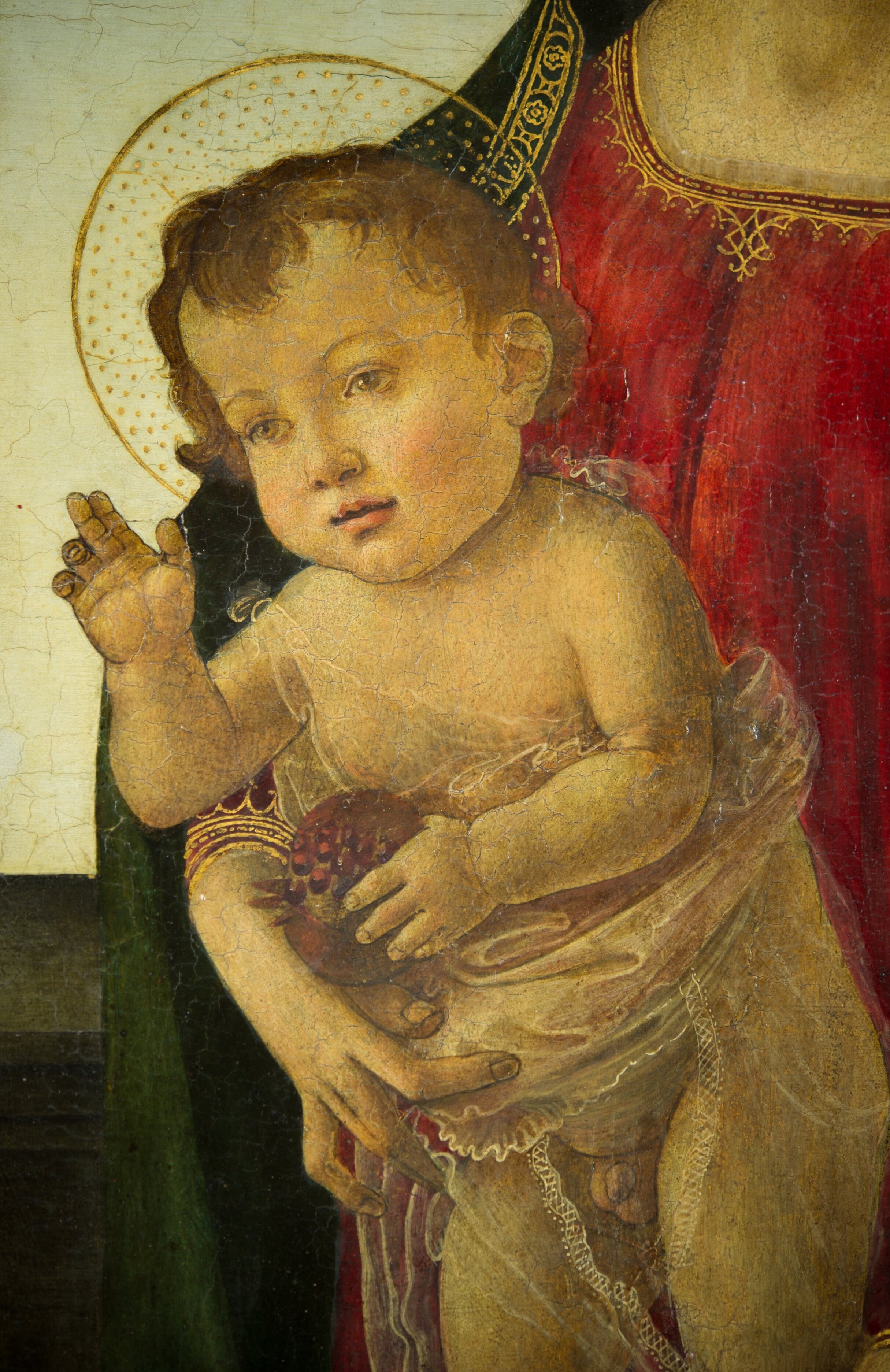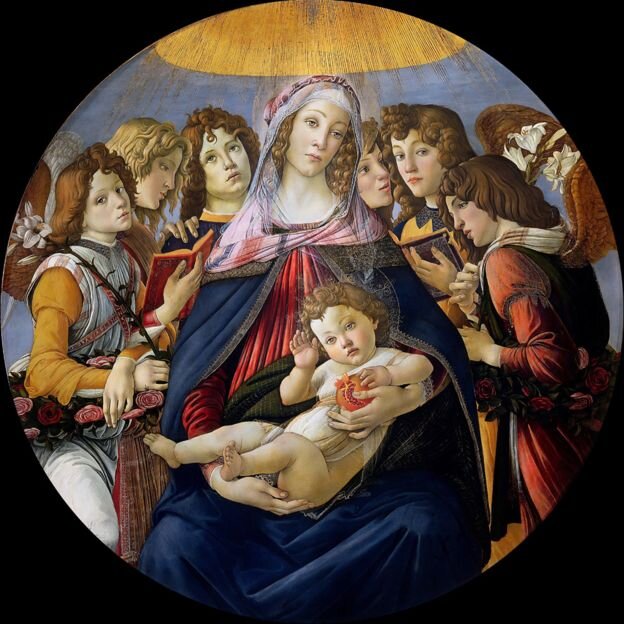‘Virgin and Child with a Pomegranate’ by Sandro Botticelli
The contents of this page appeared in a different form in an article published on the Art UK website, which you can read here.
Before treatment
After treatment
The painting was donated to the Cardiff Museum as part of a very valuable bequest by two sisters from mid-Wales, Margaret and Gwendoline Davies, granddaughters of one of the most successful entrepreneurs of the 19th century. Gwendoline died in 1951 and the Botticelli was donated as part of her bequest, another 152 objects joined in 1963 after Margaret died. You can read about the sisters here.
When Gwendoline bought the picture, it was considered to be by Botticelli, but shortly after it arrived at the museum, experts began to doubt the attribution to Botticelli, and it was downgraded to the status of a later copy by an unknown artist. What made them suspicious? The arched background was out of place, and layers of overpaint and old varnish over the Madonna and child obscured the painting’s quality.
Thanks to research by Bendor Grosvenor and conservation by Simon Gillespie Studio, the painting has now been identified as originating from Botticelli’s workshop in the 1480s, with significant parts of it likely done by Botticelli himself.
The painting will now go on display for the first time in a decade, catalogued as ‘Attributed to Botticelli and Workshop’. It is hoped that further research and discussion with other Botticelli scholars will help confirm the painting’s history and attribution.
The picture relates to the central figures in Botticelli’s 'San Barnaba Altarpiece' of about 1485 which is in the Uffizi Gallery, Florence. Sandro Botticelli lived and worked in Florence all his life. He employed a number of assistants in his studio to help him meet the demand for his artworks. Clients with a more limited budget might commission a smaller copy of Botticelli’s popular large-scale artworks, with fewer details and a simpler composition, and these might be painted either in part or entirely by Botticelli’s assistants. Is the Cardiff picture one of those commissions?
The San Barnaba altarpiece (detail)
Cleaning and analysis have revealed a work of extraordinary quality, with areas including the Madonna’s head painted in Botticelli’s distinctive manner.
One of the first things we observed was that the cracks in the area of the background were not real cracks but had been painted on and faked to make the background look old. Not a good first sign! But in spite of this unpromising first look, there were hints that the picture might be one one of great quality.
With scientific analysis and conservation treatment, an unexpected secret was revealed, and the picture emerged transformed.
Removing the dirt, old varnish, and hard overpaint was a meticulous process which was carried out in large parts under the microscope by Maria-Giulia. The treatment revealed a work of extraordinary quality, with areas including the Madonna’s head painted in Botticelli’s distinctive manner.
It was also discovered that the arched background was the work of a later artist, added in the early twentieth century, probably to hide the fact that the painting had been significantly reduced in size from a larger work. After discussion with the museum, it was decided to keep the added background, to reflect the painting’s history.
X-rays, infrared photography and cross-sections of the paint structure were taken to inform the conservation process.
The Virgin’s face before treatment
The Virgin’s face after treatment
Bendor Grosvenor said: “The restoration has transformed the painting. It’s as if a veil has been lifted and the purity of the Madonna’s countenance is shining through once more. The colour is back in the chubby cheeks of the Christ child… The work Simon has done has brought this painting back to life”
Simon Gillespie said: “Helping to bring this 500 year old painting back to life was both nerve-wracking and thrilling. We had to proceed millimetre by millimetre, given the fragility of the panel and the original paint layers. Removing the dirt and old varnish to reveal the true beauty of the Madonna’s features felt like witnessing the rebirth of a masterpiece.”
Christ’s face before treatment
Christ’s face after treatment
Christ before treatment
Christ after treatment
Infra-red photographs, which are used to show carbon drawing lines underneath the paint layers, revealed under-drawing in a style typical of Botticelli’s studio. Even more exciting, the drawing lines showed that the artist had made numerous changes in areas including the hands, proving that the painting was not a simple copy.
Infrared photo showing the original drawing lines of the Madonna’s hand underneath the pomegranate
The x-ray photographs also revealed a secret kept hidden for over 500 years: underneath the paint layers was a carbon drawing showing the profile of a man’s head, a doodle almost certainly by Botticelli before the paint was applied in that area. This is a wonderful example of how modern technology enables us to reveal aspects of a painting that are impossible to see with the naked eye and have therefore been kept hidden for centuries.
X-ray showing a doodle underneath the paint layers
In collaboration with Britta New of the National Gallery, a panel tray was made to reinforce the painting. This new structure gently supports the panel whilst allowing small movements in response to humidity changes. If these movements are impeded, a build-up of stresses could possibly lead to new cracks in the wooden painting support.
Laurence Kanter, Chief Curator of the Yale University Art Gallery and an expert in Botticelli’s works, said of this painting after treatment:
"Clearly this beautiful painting came from Botticelli’s studio. Probably Botticelli himself is responsible for more than a bit of it. A great deal more study is needed to solve the riddles of ‘how much’, ‘what parts’, ‘why’, ‘when’, and hopefully the painting can now be studied further by scholars and the public alike."
The painting will now go on display, catalogued as ‘Attributed to Botticelli and Workshop’. Hopefully, ongoing research and discussion with other Botticelli scholars will help to confirm the painting’s attribution.
Adam Webster, chief conservator at National Museum Wales, said: "The results are striking and demonstrate the crucial role that conservation plays in the proper understanding of our heritage. We are delighted with and grateful for the results. The painting now sits beautifully in our galleries and I hope fans of the series will come and enjoy this masterpiece.”
It has been hugely exciting to bring this masterpiece back to life, enabling its true quality to be recognised. Far from being the work of a later copyist, it is now clear that the painting came from Botticelli’s workshop and Botticelli himself painted at least parts, if not all of it.
This discovery follows another one earlier this year, when English Heritage confirmed that the ‘Madonna of the Pomegranates’ at Rangers House, long thought to be a later copy of the original in the Uffizi, is in fact from Botticelli’s workshop. Click here to read more.
‘Madonna of the Pomegranate’ by Sandro Botticelli
Uffizi Gallery, Florence
‘Madonna of the Pomegranate’ by workshop of Botticelli
Ranger’s House, London























